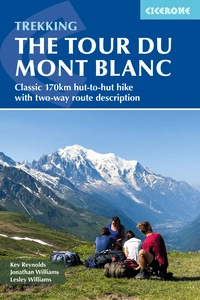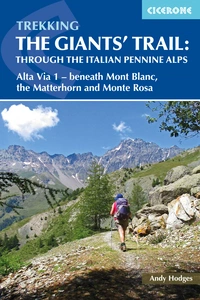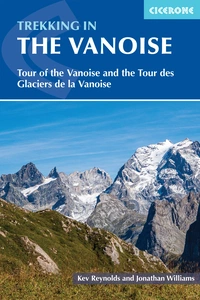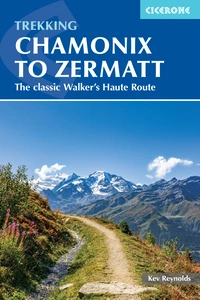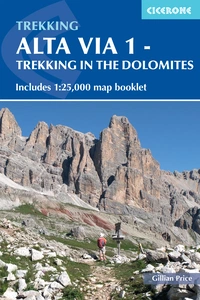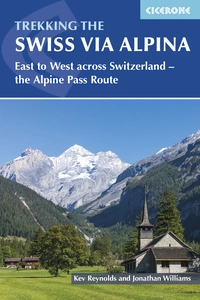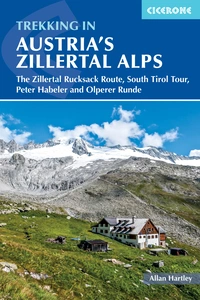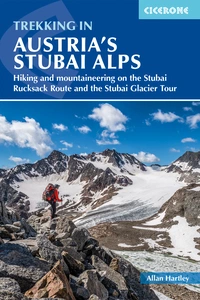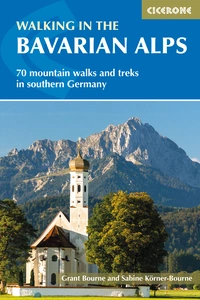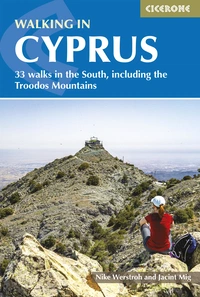Five alternative hikes to the Tour du Mont Blanc
Already walked the Tour du Mont Blanc? Or planning a trip and finding the accommodation is already fully booked? Don't worry, the Alps are packed with fantastic hiking trails for you to explore. Here's a summary of five great Mont Blanc alternatives.
Trekking the Tour du Mont Blanc
Classic 170km hut-to-hut hike with two-way route description
£17.95
Guidebook for hiking the Tour du Mont Blanc, one of the world's classic treks. The 170km (105 mile) TMB route via France, Italy and Switzerland typically takes 11 days, and can be walked in anti-clockwise and clockwise directions. With trek planning resources, accommodation guide and 5, 7 and 9-day options. A 1:25,000 IGN map booklet is available separately.
More information1. The Giants' Trail (Alta Via 1) – more challenging than the TMB
Summary: Close to Mont Blanc, but a bit more challenging
Where: Italy
How long: 180km
How many days: 14-16
How hard: Suitable for hikers with some experience of Alpine trekking.
The Giants' Trail is a great alternative to the Tour du Mont Blanc, offering fantastic Alpine walking, welcoming refuges and small hotels providing overnight accommodation (and great food) along the way. The route crosses cols of nearly 3000m as it traverses the side-valleys of the main Aosta Valley. The walking is demanding but without technical difficulty and offers breathtaking vistas of magnificent mountain landscapes, framed by towering, snow-clad giants.
Fun fact: The trail is nicknamed "Giants" because it passes Europe's highest peaks: Monte Rosa (4634m), Matterhorn (4478 m), and Mont Blanc (4809m).
Trekking the Giants' Trail: Alta Via 1 through the Italian Pennine Alps
Beneath Mont Blanc, the Matterhorn and Monte Rosa
£16.95
Guidebook to trekking Italy's Alta Via 1 - a 180km trail through the Italian Alps, following the northern flank of the Aosta Valley from Donnas to Courmayeur. Nicknamed the Giants' Trail, the route offers fantastic views of the Alpine giants: Mont Blanc, the Matterhorn and Monte Rosa. With travel advice and accommodation listings.
More information2. Trekking in the Vanoise – easier than the Tour du Mont Blanc
Summary: Something a bit easier than the TMB
Where: France
How long: 163km Tour of the Vanoise, 72km Tour des Glaciers de la Vanoise
How many days: 11 day Tour of the Vanoise and 5 day Tour des Glaciers de la Vanoise
How hard: Ideal for those new to Alpine trekking.
The Vanoise is a quintessentially Alpine trekking wonderland, with high peaks, gleaming glaciers, valleys glistening with lakes and streams, towering moraine walls and impossibly steep rock slabs. These routes are perfect for exploring this magnificent region, and compared to the Tour du Mont Blanc the days are shorter, there's less up and down and the hiking is easier.
Fun fact: The Vanoise became France’s first-ever official national park in 1963.
Trekking in the Vanoise
Tour of the Vanoise and the Tour des Glaciers de la Vanoise
£18.95
A guide to the Tour of the Vanoise, a 150km hut-to-hut trek in the French mountains between Mont Blanc and the Ecrins, described in 11 day stages from Modane. Also included are the Tour des Glaciers de la Vanoise together with suggestions for other multi-day treks in the national park.
More information3. Chamonix to Zermatt – The Walker’s Haute Route
Summary: Something a bit more challenging
Where: French and Swiss Alps
How long: 225km
How many days: 14
How hard: Suitable for walkers with a good level of fitness and previous Alpine trekking experience.
This classic trek between the mountain centres of Chamonix and Zermatt, from Mont Blanc to the Matterhorn, is a strong contender for the most beautiful walk in Europe. It's a bit wilder than the TMB, the days are longer and the cols higher. It’s a valley to valley, village to village trek, readily achieved inside two weeks – but you will need to be quick booking accommodation as this trek is also justifiably popular.
Fun fact: In English, Haute Route translates to High Road. You pronounce it like “Oat Root.”
Trekking Chamonix to Zermatt
The classic Walker's Haute Route
£18.95
Guidebook to the Walker's Haute Route from Chamonix to Zermatt. The 225km route typically takes 2 weeks to walk. Described in 14 stages, the route crosses 11 passes between Mont Blanc and the Matterhorn and involves more than 14,000m of ascent and descent. A complete guide for planning and walking the route, with accommodation information
More information4. Alta Via 1 – a fantastic TMB alternative in the Dolomites
Summary: Go east and see the spectacular Dolomites
Where: Italian Dolomites
How long: 115km
How many days: 11
How hard: It's an ideal introduction to trekking in the Dolomites for those with a moderate level of fitness.
Towers of dolomitic limestone soaring skywards, good paths, sensible trekking days, great huts, Italian food... what’s not to like about the AV1? The trek has easy access from Venice and Treviso and fits comfortably inside two weeks. If you're feeling bold (and have suitable gear) you can take in a few via ferratas too.
Fun fact: This route passes a number of relics of the fighting that took place here during World War I.
Alta Via 1 - Trekking in the Dolomites
Includes 1:25,000 map booklet
£18.95
Guidebook describing the 115km Alta Via 1, a hut-to-hut long-distance trail through the magnificent Italian Dolomites. Easier than the other AV trails, the route extends from Lago di Braies to La Pissa and is described in 11 stages. It offers majestic mountain vistas, including views of the Marmolada, Pelmo and Civetta. Includes 1:25K map booklet.
More information5. The Eiger and Jungfrau – a challenging alternative to the TMB
Summary: The middle section of the Swiss Via Alpina
Where: Switzerland
How long: 400km in total
How many days: 7-21
How hard: A serious challenge suitable for experienced trekkers.
The Swiss Via Alpina snakes across Switzerland, keeping tight against the northern wall of the alps. Passing through charming mountain villages, over high cols and with a good selection of fine huts, doing the whole route is a great 3 week trek. But to fit inside 2 weeks, tackle the middle section from say Altdorf (or Engelberg or Meiringen for a one-week trek) and pass under the Eiger, Mönch and Jungfrau, the mountain villages of Grindelwald and Mürren, finishing over the tough Sefinenfurgga and Hohe Turli cols to reach Kandersteg. This trek has it all – good transport, Swiss efficiency, easily accessed valleys, and fantastic walking.
Fun fact: Part of the Swiss Via Alpina is called "The Bear Trek", a name derived from times where only bears and wolves could navigate the route.
Trekking the Swiss Via Alpina
East to West across Switzerland - the Alpine Pass Route
£18.95
Guidebook to the Swiss Via Alpina, a 400km trek east-west across Switzerland, with options of detouring along the Alpine Pass Route. This demanding 3-week trek crosses 16 passes, including the 2778m Hohtürli, in a total of 19 stages from Sargans to Montreux, as well as a prologue stage from Liechtenstein. Requires good fitness and experience.
More informationThat concludes our top five recommendations for alternative hikes in the Alps – they're perhaps lesser-known, but definitely not less beautiful. If you still have your heart set on hiking the Tour du Mont Blanc, consider going early or late in the season. You may encounter snow on the higher cols if you go in June, but September is one of the best trekking months, being cooler, quieter and often with clearer weather. Enjoy!

